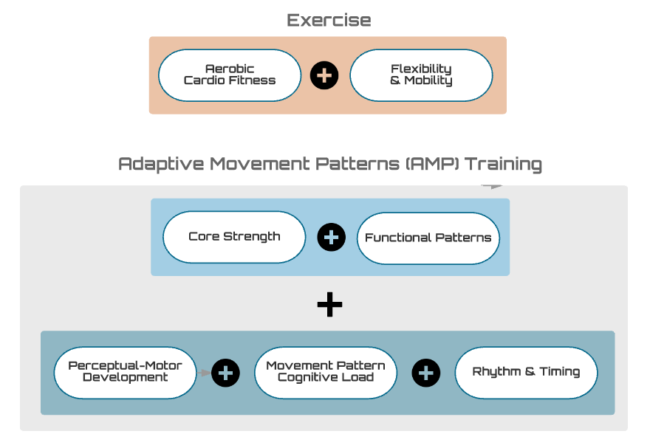We want to do two things when brain training:
(1) grow new stem-cell neurons – the raw material for neuroplasticity
(2) integrate the new cells into brain circuits before they die off through programmed cell death
For these two goals, Tracey Shors has shown that coupling aerobic exercise with mental training can be especially beneficial for cognitive enhancement.
For mental training, we have looked at focused attention meditation and how this works effectively.
We’ve also looked at Adaptive Movement Pattern (AMP) mind-body training – of the sort developed by Dr David Moreau at the University of Aukland.

We’ll now look at scientifically designed IQ Mindware apps, and how they optimize cognitive performance.
There are 3 elements in IQ Mindware brain training: (1) Attention focus and chunking training; (2) Working memory training; (3) Executive function training. In this article we’re looking at the first of these.
Attention Focus & Chunking: Expert Perception
Experts in any field differ from novices in their perception. More generally, smarter people have a better ability to quickly learn how to perceive a situation.
Perception is an active process: we select and organize the data that bombards our senses using our knowledge base. Experts literally “see” situations differently to novices. This perceptual advantage is key to experts performance advantage.
Example from chess
Here is an example from chess. How is this configuration seen by a novice compared to an International Master compared to a Grandmaster? And what do YOU see when you see this chess board?
A novice will only be able to take in one piece at a time, scanning from one to the other – like this. From this scanning, inferences are made about how to evaluate the game or make another move.
An International Master (IM) on the other hand sees ‘chunks’ of multiple pieces – familiar patterns, meaningful relationships of pieces, that are instantly seen as a unit – like the ones below. IMs have been estimated to have about 100,000 chunks that organize their perception.
A Grandmaster may perceive an entire arrangement of pieces as one meaningful unit – one chunk, like this:
And research looking at where the eyes scan or ‘fixate’ also reveal striking differences between experts and novices. Experts perceive the relational elements of a scene in parallel while novices perceive elements one by one, and experts look at the key features of the situation more rapidly. This can be seen in below, where the chess expert quickly scans to where most of the moves will develop.
What is true for chess experts is true for experts in any domain. Experts literally see problems differently from novices: they see meaningful patterns and relationships, while novices just see the unrelated elements.
Not only do experts see or ‘read’ more complex chunks or units of meaningful information. They can also use these meaningful chunks for figuring things out, or stringing together action plans, in working memory. Seeing more effectively increases their processing ‘bandwidth’.
Training The Ability To ‘See More’ and Chunk Better
Evidence from the brain wave and chunking literature tells us that certain types of brain training can make the process of getting expertise through seeing and chunking more efficient.
Any kind of working memory training that has the following can improve the ability to ‘see’ meaningful patterns, and learn new chunks for developing expertise:
(1) Interference control training
(2) Learning to recognize new objects in working memory games
(2) Training the ability of attention to ‘bind’ different types of information together
Interference control training (1) is built into all IQ Mindware apps.
Recognition training (2) is built into HighIQPro’s 2G Plus (non-categorical) brain training game.
Attention binding training (3) is built into the output gating games in the IQ Mindware apps.
Training Gamma Wave Synchrony for Seeing & Chunking
Why does this kind of brain training work?
The answer lies in improving gamma wave synchrony and power in the hippocampus where – new brain circuits encode the chunks of perception needed for expertise and processing capacity.
Quick tutorial on brain wave synchrony
All your perceptions, thoughts, decisions and physical actions are coded in electrical and chemical activity in the neural networks of your brain. When you tap away on your computer, somehow your brain has got to bind together information processed in different parts of your brain.
A couple of decades of neuroscience work in labs tells us that synchronized brain waves (or ‘neural oscillations’) in the brain is one of the most important mechanisms for flexibly selecting and binding neural activity in different parts of the brain. These coherent waves can be detected as electrical activity at the scalp using EEG.
Here is a video showing brain cell synchronization, captured on film:
There are different brain wave frequencies that the brain can synchronize (or ‘phase lock’) with. These are:
Gamma band synchronization is critical for attention focus and chunking (1).
During working memory tasks, information is segregated and ‘chunked’ into meaningful units in the hippocampus via gamma synchrony.
The 3 types of training tasks built into IQ Mindware apps makes this chunking process more efficient. They enhance gamma wave synchrony resulting in a higher baseline gamma power. This in turn results in efficient formation of new brain cell circuits for meaningful ‘chunks’ in perception and working memory – which improves not only perception, but overall intelligence.
The same effect can be achieved through gamma neurofeedback training (2):